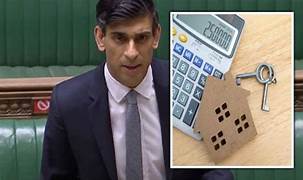Digital Zeitgeist – Skyrocketing Mortgage Rates Breach 6% Ceiling: Causes Consequences and Countermeasures
The mortgage market is heating up, with rates surpassing the 6% threshold for the first time in years. Average mortgage rates for a two-year fixed deal have soared to an eye-watering 6.01%, as reported by Moneyfacts, a leading financial information company. The average five-year fixed rate deal, meanwhile, has climbed to 5.67%, up from 5.62% just days ago.
These figures represent the highest rates since 1st December 2022 when the market was rocked by Liz Truss’s mini-budget debacle. Not since November 2008 have rates for two-year fixed deals ascended to the 6% landmark.
Spiking Mortgage Rates and Government Response
The unprecedented surge in mortgage rates comes despite calls for government support. Prime Minister Rishi Sunak has declined to extend additional assistance to mortgage holders, even as higher interest rates burden homeowners with increased payments. Likewise, Chancellor Jeremy Hunt, when queried about introducing financial support to alleviate the cost of mortgage bills, echoed similar sentiments to those about energy bill aid.
“I know the anxiety people will have about mortgage rates,” Mr Sunak admitted. “That’s why the first priority I set out at the beginning of the year was to halve inflation because that’s the best and most important way that we can keep costs and interest rates down for people. We’ve got a clear plan to do that. It is delivering. We need to stick to the plan.”
Labour Party Leader Sir Keir Starmer, while ruling out direct mortgage support, pledged to aid citizens with their bills, proposing an increased windfall tax on oil and gas companies.
The Availability Conundrum
Moneyfacts data further reveals a decline in mortgage product availability. The total number of available mortgages has decreased from 4,923 to 4,683 over the past week. Despite this downturn, the current availability still surpasses the figure before the September mini-budget of unfunded tax cuts and increased spending, which stood at 3,890.
The Resolution Foundation, a prominent think tank, has forecasted an average rise of £2,900 in annual mortgage repayments for those renewing next year.
Weighing Risks Against Assistance
Sir Charlie Bean, former Bank of England deputy governor, has cautioned against government intervention, deeming it risky for the government to shield mortgage holders from rising interest rates. “Borrowing money to subsidise mortgages risks fuelling inflation further, forcing the Bank of England to respond with even higher interest rates. It would be totally self-defeating,” warned a Treasury source.
Meanwhile, Mr Sunak emphasised existing measures to assist first-time buyers and help them onto the property ladder. “There is also support available for people – we have the mortgage guarantee scheme for first-time buyers, and we have the support for mortgage interest scheme to help people as well. That’s why one of my first priorities is to halve inflation.”
The Devil’s Advocate: Are the Countermeasures Adequate?
While the mortgage rate surge is concerning, it’s essential to consider multiple perspectives. The government’s approach to easing inflation over providing direct financial support for mortgages could be viewed as tackling the root cause. Halving inflation could, in the long term, lead to reduced costs and interest rates, arguably a more sustainable solution than subsidising mortgages, which could inadvertently fuel inflation.
However, one might argue that these macroeconomic measures, while essential, may not provide immediate relief to those individuals struggling to meet their mortgage payments in the short term. The government’s stance on not providing direct support for mortgage holders may be seen as dismissive of the immediate hardship many homeowners are experiencing.
Moreover, critics may question the efficacy of existing schemes touted by the Chancellor. For instance, while the mortgage guarantee scheme and support for mortgage interest scheme aim to aid first-time buyers and existing homeowners, do these measures suffice given the soaring rates? Are they accommodating enough to provide immediate relief to the struggling majority, or are they only a drop in the ocean?
And then there’s the perspective of the Bank of England and financial experts who caution against government intervention. They argue that subsidising mortgages may create an inflationary spiral, leading to even higher interest rates, which may ultimately harm rather than help homeowners.
Furthermore, while Sir Keir Starmer’s proposition of an increased windfall tax on oil and gas companies may help alleviate bill payments, will it truly assist with mortgage burdens, or is it merely a deflection from the larger issue at hand?
In Conclusion: A Balancing Act
Navigating the rocky terrain of a mortgage crisis is a delicate balancing act. The current government approach, focused on reducing inflation and citing existing schemes, seems oriented towards long-term stability rather than immediate relief. Critics may argue this dismisses the short-term pain felt by many homeowners.
However, offering direct support to mortgage holders could risk exacerbating inflation, leading to even higher interest rates, thus creating a vicious cycle. It seems the path to the best solution is fraught with complexity and challenges.
As mortgage holders, market players, and observers alike wait with bated breath, one thing is certain: the path to resolution requires a careful balance of measures to support those burdened by these soaring rates, while also ensuring the country’s economic stability. Both immediate relief for struggling homeowners and a robust, inflation-curbing strategy are vital, illustrating the crucial importance of not just treating the symptoms, but also addressing the root cause.
Disclaimer: The views and opinions expressed in this article are those of the author and do not necessarily reflect the official policy or position of GPM-Invest or any other organisations mentioned. The information provided is based on contemporary sourced digital content and does not constitute financial or investment advice. Readers are encouraged to conduct further research and analysis before making any investment decisions.

